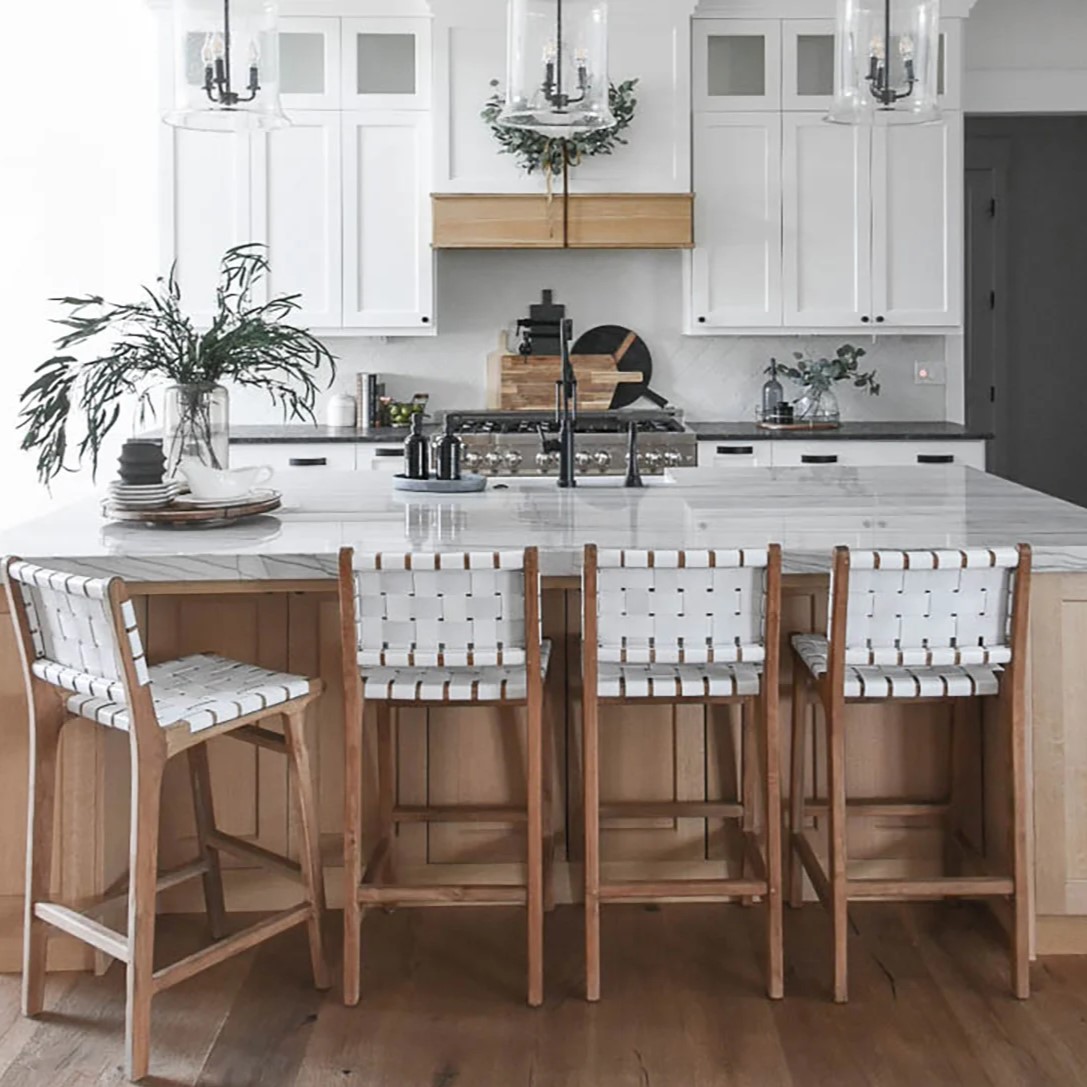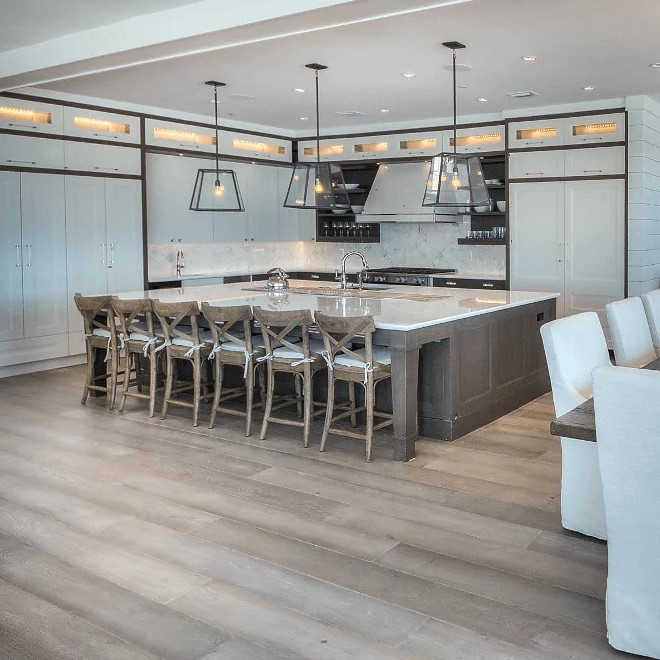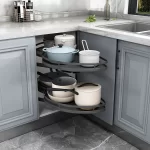In the heart of every home lies the kitchen, a space where functionality meets style. One of the most impactful additions to elevate both the aesthetic and practicality of your kitchen is a large kitchen island. This versatile centerpiece not only provides ample workspace but also serves as a hub for social interactions, cooking endeavors, and storage solutions. Whether you’re renovating your kitchen or designing a new one, understanding the benefits and possibilities of a large kitchen island can help you make an informed decision that enhances your culinary experience.
 The Multifaceted Benefits of a Large Kitchen Island
The Multifaceted Benefits of a Large Kitchen Island
Enhanced Workspace and Efficiency
A large kitchen island significantly increases the available workspace, making meal preparation more efficient. By offering additional counter space, you can effortlessly manage multiple tasks simultaneously, such as chopping vegetables while simmering a pot on the stove. Moreover, the abundance of surface area reduces clutter, allowing you to keep essential tools and ingredients within easy reach.
Central Hub for Social Interaction
Beyond its functional advantages, a large kitchen island serves as a social hub where family and friends can gather. Whether it’s enjoying a casual breakfast, sharing a conversation while cooking, or hosting parties, the island fosters a sense of community. With integrated seating options, it provides a comfortable space for guests to sit and interact, ensuring that the kitchen remains a lively and inviting area.
Increased Storage Solutions
Storage is a crucial aspect of any kitchen, and a large kitchen island excels in this area. It typically features multiple cabinets, drawers, and shelves, offering ample space to store cookware, utensils, and pantry items. Additionally, some islands come with specialized storage options, such as wine racks or spice drawers, further enhancing their utility. This organized storage helps keep your kitchen tidy and ensures that everything you need is easily accessible.
Designing the Perfect Large Kitchen Island
Choosing the Right Size and Shape
When selecting a large kitchen island, it’s essential to consider the size and shape that best fits your kitchen layout. Measure the available space to ensure that the island complements the overall design without overcrowding the room. Common shapes include rectangular, L-shaped, and oval, each offering different advantages. For instance, a rectangular island provides extensive workspace, while an oval shape can facilitate better movement around the kitchen.
Selecting the Ideal Materials
The materials used in your kitchen island play a significant role in both its durability and appearance. Popular options include granite, quartz, marble, and butcher block for countertops, each offering unique textures and colors. The base can be crafted from wood, metal, or laminate, depending on your desired aesthetic and budget. It’s important to choose materials that not only match your kitchen’s style but also withstand daily wear and tear.
Incorporating Functional Features
A large kitchen island can be customized with various functional features to enhance its usability. Consider adding a built-in sink or cooktop to streamline cooking processes. Incorporating electrical outlets allows you to power appliances or charge devices conveniently. Additionally, features like under-counter lighting or a retractable faucet can add both practicality and a touch of modern elegance to your island.
Integrating Seating Options
To maximize the social aspect of your kitchen island, integrating seating is essential. Bar stools or chairs positioned along one or more sides of the island provide a comfortable space for guests to sit while you cook. When selecting seating, consider the height and style to ensure it complements the island’s design and offers adequate support. Additionally, choose materials that are easy to clean and maintain, as kitchen seating is subject to frequent use.
 Optimizing Space with a Kitchen Island
Optimizing Space with a Kitchen Island
Creating an Efficient Layout
An efficient kitchen layout revolves around the strategic placement of the kitchen island. To optimize space, ensure that there is sufficient room for movement around the island, adhering to the recommended clearance of at least 42 inches on all sides. This allows for smooth traffic flow and easy access to other kitchen areas. Additionally, position the island near key appliances, such as the stove and refrigerator, to facilitate a functional work triangle.
Enhancing Lighting and Ambiance
Lighting plays a crucial role in both the functionality and ambiance of your kitchen island. Install pendant lights or chandeliers above the island to provide focused illumination for cooking and meal prep. Additionally, under-cabinet lighting can enhance visibility and highlight the island’s features, creating a warm and inviting atmosphere. Consider incorporating dimmable lighting options to adjust the brightness based on your needs and the time of day.
Balancing Aesthetics and Functionality
Achieving a balance between aesthetics and functionality is key to designing a successful large kitchen island. While it’s important to focus on practical aspects such as storage and workspace, the island should also complement the overall kitchen design. Choose colors, finishes, and styles that harmonize with your cabinetry, flooring, and backsplash. This cohesive approach ensures that the island enhances the kitchen’s visual appeal without compromising its functionality.
Maximizing Storage with a Kitchen Island
Utilizing Cabinets and Drawers
A large kitchen island offers abundant storage options through its cabinets and drawers. Utilize these spaces to store kitchen essentials, such as pots, pans, and utensils, keeping them organized and easily accessible. Deep cabinets are ideal for bulky items like mixers and blenders, while shallow drawers can accommodate smaller tools and gadgets. Consider incorporating soft-close mechanisms to enhance the user experience and prevent slamming.
Incorporating Open Shelving
In addition to traditional storage solutions, open shelving can add both functionality and style to your kitchen island. Displaying frequently used items, such as spices, cookbooks, or decorative pieces, adds a personal touch to your kitchen. Open shelves also create an airy feel, preventing the island from appearing too heavy or cluttered. Balance open shelving with closed storage to maintain an organized and visually appealing space.
Adding Specialized Storage Features
To further enhance the storage capacity of your large kitchen island, consider adding specialized features. Wine racks, for instance, provide a dedicated space for your favorite beverages, while spice drawers keep your seasonings neatly organized. Additionally, appliance garages or pull-out pantry shelves offer convenient storage for appliances and dry goods, keeping your kitchen clutter-free and functional.
 Enhancing Functionality with a Kitchen Island
Enhancing Functionality with a Kitchen Island
Integrating Appliances
Incorporating appliances into your kitchen island can significantly boost its functionality. A built-in cooktop or sink allows for seamless meal preparation, while a dishwasher under the island simplifies cleanup. Additionally, integrating small appliances like microwaves, toasters, or coffee makers into the island design helps streamline your kitchen workflow and frees up countertop space.
Creating a Multi-Purpose Space
A large kitchen island can serve multiple purposes beyond cooking and storage. Transform it into a dining area by incorporating a breakfast bar, providing a casual spot for meals. Alternatively, use one side of the island as a dedicated workspace for tasks like homework, crafting, or even a home office setup. This multi-purpose functionality ensures that your island adapts to your changing needs and maximizes the utility of your kitchen space.
Enhancing Kitchen Technology
Modern kitchens increasingly incorporate advanced technology to enhance functionality. Your large kitchen island can feature smart technology, such as touch-activated faucets, built-in charging stations, or integrated speakers. Additionally, consider installing a pop-up power outlet or USB ports to conveniently charge your devices while working in the kitchen. These technological enhancements not only improve convenience but also add a contemporary flair to your kitchen design.
Choosing the Right Materials for Your Kitchen Island
Durable Countertop Options
Selecting a durable countertop material is essential for the longevity and functionality of your large kitchen island. Granite and quartz are popular choices due to their resistance to scratches, heat, and stains. Marble offers a luxurious appearance, although it requires more maintenance to prevent damage. For a more budget-friendly option, butcher block provides a warm, natural look while being easy to repair and refinished as needed.
Stylish Base Materials
The base of your kitchen island contributes significantly to its overall style and durability. Wood bases offer a classic and versatile look, suitable for various kitchen designs. Metal bases provide a sleek, modern aesthetic and are incredibly durable. Laminate options are cost-effective and come in a wide range of colors and patterns, allowing for easy customization to match your kitchen’s decor.
Complementary Finishes and Accents
Enhancing your large kitchen island with complementary finishes and accents can elevate its visual appeal. Consider adding a contrasting backsplash to highlight the countertop, or incorporate decorative molding on the cabinets to add a touch of elegance. Additionally, hardware such as knobs and handles can be selected to match your kitchen’s style, whether it’s contemporary, rustic, or traditional. These finishing touches create a cohesive and polished look for your kitchen island.
 Practical Tips for Maintaining Your Kitchen Island
Practical Tips for Maintaining Your Kitchen Island
Regular Cleaning and Maintenance
To keep your large kitchen island looking its best, regular cleaning and maintenance are essential. Wipe down the countertop daily with a suitable cleaner to remove spills and prevent stains. For granite or quartz surfaces, use a non-abrasive cleaner to avoid damaging the finish. Metal bases should be polished periodically to maintain their shine, while wooden elements may require occasional sealing or oiling to protect against moisture and wear.
Addressing Wear and Tear
Over time, your kitchen island may show signs of wear and tear. Addressing these issues promptly ensures the longevity of your investment. Scratches on countertop surfaces can often be buffed out or professionally repaired, depending on the material. Loose hardware should be tightened, and any damaged cabinetry repaired to maintain the structural integrity and appearance of the island.
Updating and Refreshing Your Island
Keeping your large kitchen island updated with the latest trends and your evolving style preferences can refresh your kitchen’s look. Consider repainting or refinishing the cabinets to give them a new appearance. Replacing the countertop with a different material or color can also transform the island’s aesthetic. Additionally, updating lighting fixtures or adding new hardware can provide a modern touch without requiring a complete overhaul.
Incorporating Sustainable Practices with a Kitchen Island
Choosing Eco-Friendly Materials
Embracing sustainability in your kitchen design is increasingly important, and a large kitchen island can reflect these values. Opt for eco-friendly materials such as reclaimed wood for the base or countertops made from recycled glass. Additionally, choosing low-VOC paints and finishes reduces the environmental impact and promotes healthier indoor air quality.
Implementing Energy-Efficient Features
Integrating energy-efficient features into your kitchen island can enhance its sustainability. Install LED lighting, which consumes less energy and has a longer lifespan compared to traditional bulbs. Select energy-efficient appliances, such as induction cooktops or ENERGY STAR-rated dishwashers, to reduce energy consumption. These choices not only contribute to a greener kitchen but also result in long-term cost savings on utility bills.
Reducing Waste through Smart Storage
A large kitchen island offers ample storage opportunities, which can help reduce waste by keeping your kitchen organized and minimizing food spoilage. Use the island’s storage compartments to store bulk items, reducing the need for frequent shopping trips and minimizing packaging waste. Additionally, incorporate recycling and composting bins within the island to encourage responsible waste management practices.
Personalizing Your Kitchen Island
Customizing Layout and Design
Personalizing your large kitchen island allows you to tailor it to your specific needs and preferences. Customize the layout by adding features that enhance its functionality, such as a built-in mini-fridge, a wine cooler, or a cutting board extension. Experiment with different design elements, such as open shelving, glass cabinet doors, or cabinetry with glass inserts, to create a unique and personalized look.
Adding Decorative Elements
Incorporating decorative elements into your kitchen island can reflect your personal style and add visual interest. Consider adding a statement light fixture above the island, displaying artwork on the backsplash, or using decorative tiles to accentuate certain areas. Additionally, integrating plants or small decorative items on open shelves can bring a touch of nature and warmth to your kitchen space.
Creating a Themed Island
Creating a themed kitchen island can enhance the overall design cohesion of your kitchen. For example, a farmhouse-themed island might feature distressed wood, open shelving, and vintage-inspired hardware. Conversely, a modern-themed island could incorporate sleek lines, stainless steel accents, and minimalist design elements. Aligning the island’s theme with the rest of the kitchen ensures a harmonious and visually appealing space.
Practical Considerations for Installing a Kitchen Island
Ensuring Adequate Space and Clearance
Before installing large kitchen islands, it’s crucial to ensure that there is adequate space and clearance within your kitchen layout. Measure the dimensions of the island and compare them with the available space to prevent overcrowding. Adhering to the recommended clearance distances ensures that there is enough room for appliances, cabinets, and easy movement around the kitchen.
Planning for Plumbing and Electrical Needs
Incorporating plumbing and electrical features into your kitchen island requires careful planning. If you’re adding a sink or cooktop, ensure that the plumbing connections are properly installed and meet local building codes. Similarly, plan for sufficient electrical outlets to power appliances and lighting fixtures. Consulting with a professional contractor or designer can help you navigate these technical aspects and ensure a safe and functional installation.
Budgeting for Your Large Kitchen Islands
Budgeting is a critical aspect of any kitchen renovation project, including the addition of a large kitchen island. Determine your budget early on and prioritize features that are most important to you, such as high-quality materials, integrated appliances, or custom cabinetry. Additionally, consider the long-term value and durability of the materials and features you choose, as investing in quality can result in cost savings and enhanced functionality over time.
 Final Thoughts
Final Thoughts
A large kitchen island is more than just a functional addition to your kitchen; it is a transformative element that enhances both the aesthetic and practical aspects of your culinary space. From expanding your workspace and storage solutions to creating a central hub for social interactions, the benefits of a large kitchen island are manifold. By carefully considering the design, materials, and functional features, you can create a kitchen island that reflects your personal style and meets your specific needs. Furthermore, incorporating sustainable practices and personalized touches ensures that your kitchen island remains a beloved and enduring centerpiece in your home. Embrace the versatility and elegance of a large kitchen island, and experience the perfect blend of style, functionality, and comfort in your kitchen.

